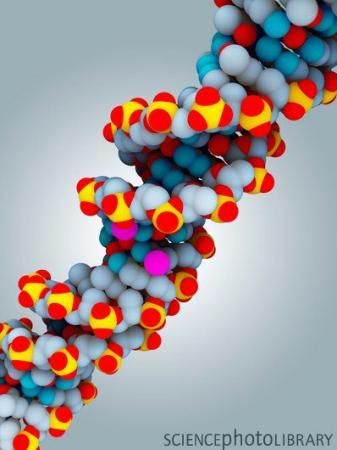
DNA分子模型(图)
在过去几年中,许多研究报道显示长期压力会引起染色体损伤,但具体仍然机制不明。美国杜克大学医学院的科学家们最新的研究发现了压力导致DNA损伤的分子机制。
这项研究的论文发表在了最新一期的《Nature》杂志上。
论文的通讯作者,Robert J. Lefkowitz教授说道:“我们证实了长期压力会通过一种特定的机制上调人体内的肾上腺素,并最终导致DNA受损。”
在研究中,小鼠被注射入一种肾上腺素类似化合物,它可通过一种名为β-肾上腺素能受体发挥作用(Lefkowitz研究该受体已有数年)。科学家们发现在这种使用药物建立的慢性压力小鼠模型中,体内会启动特定的一些生物学通路,诱导DNA的损伤并积累。
Lefkowitz教授说道:“这可以解释为何长期的压力会导致人体内环境的一系列改变和失调。”
P53是人体内的抑癌基因,被认为是基因组的“守护者”,它能阻止基因组发生异常。
Lefkowitz的实验室的一位博士后Makoto Hara说道:“研究显示长期的压力会导致体内P53表达水平一直较低,我们推测这是染色体变得无规律的根本原因。”
β-肾上腺素能受体是一种G蛋白偶联受体(GPCRs),这些受体通常表达于细胞的表面,是目前市面上一半以上药物的作用靶点。
该研究小组一直在研究起源于GPCRs的一条名为β-阻滞的信号通路。起初,他们推断β-阻滞蛋白能通过关闭或降低敏感性对G蛋白通路进行抑制,但证据显示这些蛋白的积累也会最终引发一些它们自身的生物活力。
在该研究中,肾上腺素类似化合物通过G蛋白通路和β-阻滞通路共同作用影响P53的正常表达,诱导DNA损伤。小鼠在注射该化合物的四周后,体内P53表达水平显著降低。同时科学家们还发现,在缺乏β-阻滞蛋白1的情况下,小鼠DNA不会受损。因为β-阻滞蛋白1表达缺失可有效稳定胸腺细胞内的P53表达水平(胸腺和急性、慢性压力反应相关)。(生物探索 Jun译)
生物探索推进英文论文原文摘要:
A stress response pathway regulates DNA damage through β2-adrenoreceptors and β-arrestin-1
The human mind and body respond to stress1, a state of perceived threat to homeostasis, by activating the sympathetic nervous system and secreting the catecholamines adrenaline and noradrenaline in the ‘fight-or-flight’ response. The stress response is generally transient because its accompanying effects (for example, immunosuppression, growth inhibition and enhanced catabolism) can be harmful in the long term. When chronic, the stress response can be associated with disease symptoms such as peptic ulcers or cardiovascular disorders, and epidemiological studies strongly indicate that chronic stress leads to DNA damage. This stress-induced DNA damage may promote ageing, tumorigenesis, neuropsychiatric conditions and miscarriages. However, the mechanisms by which these DNA-damage events occur in response to stress are unknown. The stress hormone adrenaline stimulates β2-adrenoreceptors that are expressed throughout the body, including in germline cells and zygotic embryos. Activated β2-adrenoreceptors promote Gs-protein-dependent activation of protein kinase A (PKA), followed by the recruitment of β-arrestins, which desensitize G-protein signalling and function as signal transducers in their own right. Here we elucidate a molecular mechanism by which β-adrenergic catecholamines, acting through both Gs–PKA and β-arrestin-mediated signalling pathways, trigger DNA damage and suppress p53 levels respectively, thus synergistically leading to the accumulation of DNA damage. In mice and in human cell lines, β-arrestin-1 (ARRB1), activated via β2-adrenoreceptors, facilitates AKT-mediated activation of MDM2 and also promotes MDM2 binding to, and degradation of, p53, by acting as a molecular scaffold. Catecholamine-induced DNA damage is abrogated in Arrb1-knockout (Arrb1−/−) mice, which show preserved p53 levels in both the thymus, an organ that responds prominently to acute or chronic stress1, and in the testes, in which paternal stress may affect the offspring’s genome. Our results highlight the emerging role of ARRB1 as an E3-ligase adaptor in the nucleus, and reveal how DNA damage may accumulate in response to chronic stress.







